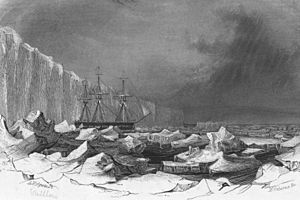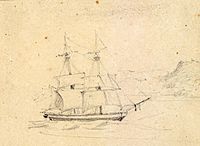USS Peacock (1813) facts for kids

Peacock in Antarctic ice, by Alfred Thomas Agate, while she was on the United States Exploring Expedition
|
|
Quick facts for kids History |
|
|---|---|
| Name | Peacock |
| Namesake | Peacock |
| Ordered | 3 March 1813 |
| Builder | Adam and Noah Brown, New York Navy Yard |
| Laid down | 9 July 1813 |
| Launched | 19 September 1813 |
| Decommissioned | October 1827 |
| Refit | Rebuilt as exploring ship, 1828 |
| Recommissioned | 1829 |
| Fate | Wrecked, 17–19 July 1841 |
| General characteristics | |
| Type | Sloop-of-war |
| Tons burthen | 509 (bm) |
| Length | 119 ft (36 m) |
| Beam | 31 ft 6 in (9.60 m) |
| Draft | 16 ft 4 in (4.98 m) |
| Propulsion | Sail |
| Complement | 140 officers and enlisted |
| Armament | 20 × 32-pounder carronades + 2 × 12-pounder bow chasers |
The USS Peacock was a special type of warship called a sloop-of-war. It served in the United States Navy during the War of 1812.
The U.S. Congress approved the Peacock's creation on March 3, 1813. It was built by Adam and Noah Brown at the New York Navy Yard. The ship was started on July 9, 1813, and launched on September 19, 1813.
Peacock was very busy during the War of 1812, capturing twenty enemy ships. After the war, it joined the Mediterranean Squadron. It also helped fight pirates in the Caribbean Sea. Later, it patrolled the coast of South America during the time when colonies were fighting for their independence.
In 1827, Peacock was taken out of service. It was then taken apart and rebuilt in 1828 to become an exploration ship. In 1838, it sailed as part of the United States Exploring Expedition. Sadly, Peacock got stuck and broke apart near the Columbia Bar in 1841, but everyone on board was safe.
Contents
War of 1812 Adventures
During the War of 1812, Peacock went on three important trips. Its commander was Master Commandant Lewis Warrington.
- First Trip: On March 12, 1814, Peacock left New York. It sailed to deliver supplies to a naval base in Georgia. Off the coast of Florida, on April 29, it captured a British ship called HMS Epervier. The U.S. Navy then used this captured ship as the USS Epervier.
- Second Trip: Peacock left Georgia on June 4 for its next journey. It sailed to the Grand Banks and along the coasts of Ireland and Spain. On this trip, Peacock captured 14 British merchant ships. It returned to New York through the West Indies.
- Third Trip: On January 23, 1815, Peacock left New York with two other ships, Hornet and Tom Bowline. They sailed around the Cape of Good Hope into the Indian Ocean. In Indonesia, Peacock captured three merchant ships in June.
The War's Final Action
On June 30, 1815, Peacock captured a British ship called HCS Nautilus. This happened in the Straits of Sunda, Indonesia. The commander of Nautilus told Captain Warrington that the war had ended. But Warrington thought it might be a trick and ordered the British ship to surrender.
When the British captain refused, Peacock fired. Some people on the Nautilus were hurt or died. After the British captain showed documents proving the war was over, Warrington released them. This event happened after the Treaty of Ghent had been signed, which officially ended the war.
After the War
On June 13, 1816, Peacock left New York for France. It carried an important diplomat, Albert Gallatin. After dropping him off, Peacock joined the Mediterranean Squadron. It stayed there for several years, protecting American interests. In 1821, it returned home and was put into storage.
Fighting Pirates and Illness
In the 1820s, pirates were attacking ships in the West Indies. On June 3, 1822, Peacock became the main ship for Commodore David Porter's West India Squadron. Their job was to find and stop pirates.
Peacock worked with other ships to break up a pirate base in Florida. They captured four pirate vessels. The crew of Peacock also captured two more pirate ships in April 1823.
In September 1822, many crew members on Peacock became very sick with a serious illness. The ship had to go to Virginia to recover. Other ships in the area also faced similar health problems.
South Pacific and Hawaii Missions
In July 1823, Peacock was involved in the Battle of Lake Maracaibo in South America. Later, in March 1824, it sailed to the Pacific Ocean. For several months, it cruised along the west coast of South America, where countries were fighting for independence.
In September 1825, Peacock, led by Commodore Thomas ap Catesby Jones, sailed to the Kingdom of Hawaiʻi. There, they helped create a treaty of friendship and trade. From July 1826 to January 1827, the ship visited other Pacific islands. Its goal was to protect American trade and the whaling industry. On its way back from Hawaii, a whale hit the ship, causing serious damage. Despite this, it made it to Peru and then returned to New York.
USS Peacock Rebuilt for Exploration

Peacock returned to New York in October 1827. It was taken out of service and rebuilt in 1828 for a special exploration trip. Its size stayed about the same, but it had fewer guns.
When the exploration plans were delayed, Peacock went back to regular service in the West Indies from 1829 to 1831. After being refitted, Peacock and a new ship, the Boxer, were ordered to help the frigate Potomac. They also had important diplomatic missions. Peacock sailed on March 8, 1832.
Diplomatic Journeys
Peacock carried Mr. Francis Baylies and his family to Argentina. He was going to be the United States' representative there. The ship also carried Edmund Roberts, a special agent for President Andrew Jackson.
On June 25, 1832, Peacock left South America for the Cape of Good Hope. It faced a huge wave that nearly tipped the ship over.
After picking up winds, Peacock sailed to Indonesia. The crew faced health challenges, with many getting sick. Despite this, Peacock continued its journey, using careful navigation.
- Treaty with Siam: On March 20, 1833, Edmund Roberts signed a trade treaty with the King of Siam (now Thailand). Peacock then visited Singapore.
- Treaty with Oman: On August 29, 1833, in the Red Sea, Peacock saw the same British ship, Nautilus, it had attacked after the War of 1812. This time, there was no conflict. On September 13, Roberts signed a treaty with the Sultan of Muscat (now Oman).
Peacock brought Roberts back to Brazil on January 17, 1834.
Second Diplomatic Mission
On April 23, 1835, Peacock, now commanded by C. K. Stribling, set sail again from New York. It was joined by the Enterprise. Edmund Roberts was on board Peacock again. Their mission was to deliver the approved treaties to Zanzibar.
Masirah Island Incident
On September 21, 1835, Peacock accidentally ran aground on a coral reef near Masirah Island. Roberts and some crew members left in a small boat to get help. The crew had to throw 11 of their guns overboard to lighten the ship. They managed to get the ship free on September 23. The Sultan of Muscat later found the guns and sent them back to Roberts for free.
A second attempt to negotiate with Cochin-China (Vietnam) failed because Roberts became very ill. He died in Macao on June 12, 1836. A doctor on the voyage, William Ruschenberger, wrote about the journey. Peacock returned to Virginia on October 27, 1837, after being away for over two and a half years.
Exploration and Final Journey
Peacock joined the famous United States Exploring Expedition in 1838. This expedition explored many parts of the world. However, Peacock got stuck on a sandbar at the mouth of the Columbia River in Oregon. This happened on July 17, 1841. All the crew members and most of the important scientific information were safely taken off the ship before it broke apart on July 19, 1841.
Images for kids
See also
- List of historical schooners
- List of sloops of war of the United States Navy
- Bibliography of early American naval history



